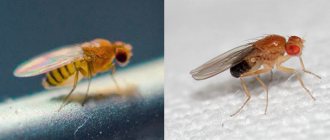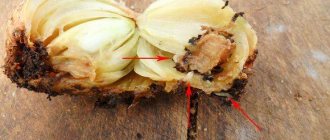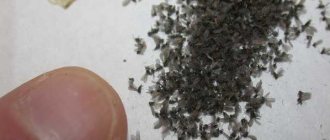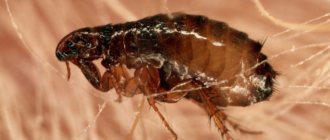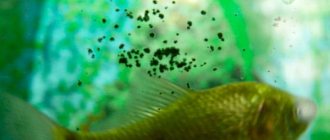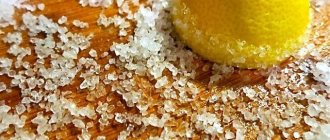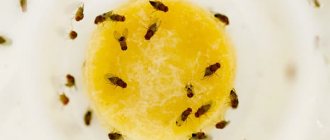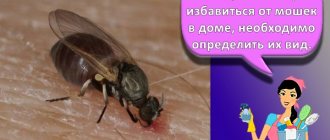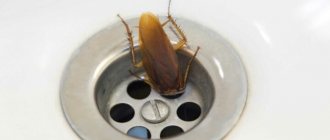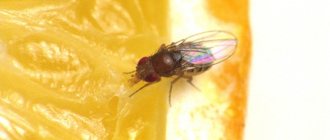Fruit flies and how to get rid of them
Drosophila melanogaster, also known as the fruit fly or vinegar fly, is a small, about 3 mm in length, insect of the Drosophiliadae family from the order Diptera.
These flies can be observed near spoiled fruits. In nature, they also feed on plant sap and rotting plant debris. The larvae also feed on microorganisms. Drosophila (we call it “wine fly”) follows the smell of wine. One way or another, everyone has encountered fruit flies. You should forget about vegetables or fruits that are stored outside the refrigerator, overwater indoor plants - they are right there. This time we got it when we put in apple cider vinegar. It's difficult to get rid of. Therefore, we are making a separate article - we are studying who they are and how to get rid of them without using chemicals.
Fruit flies (lat. Drosophilidae) are a family of the order of dipterous insects (Diptera), including more than 2000 species. It has a worldwide distribution. The most famous genus is Drosophila. Representatives of this genus are also called fruit flies.
The family includes two subfamilies - Drosophilinae and Steganinae - and about 70 genera. The larvae develop in decaying plant debris, fruits, vegetables, and mushrooms.
The easiest way to get rid of fruit flies within a few days is to completely deprive them of food. But here it is difficult to do this - in a village house, in the kitchen, there is always something for them. You can hang adhesive tape - it helps, but not much.
Young larvae cannot penetrate deep into the solid medium and die, while eggs laid in a liquid medium may die.
They say that fruit flies can also eat thermal insulation. True, this is unverified information, but rumors. However, I met them several times. Whether this is true or not, I don’t know.
The fruit fly, Drosophila melanogaster, is known to many aquarists. Both adult insects and their larvae are used as food.
Types of midges and reasons for their appearance
Midges are two-winged insects that are similar to flies, only smaller in size. There are three types of pests most commonly found in kitchens. Here it’s worth mentioning right away where they come from in the apartment, because they penetrate your life in completely different ways.
- Drosophila - they are also called fruit and wine midges. They are easily recognized by their dark yellow, orange, brown or black color. They love rotten remains of fruits and vegetables, waste from the trash can and sweets. They are able to take a liking to wet rags that have been lying around for a long time. You bring them from the market or from the grocery store.
- Sewer flies are black in color, their bodies are densely covered with hairs. They live in sewers and other damp and warm places. They appear if food waste has accumulated in the drain.
- Sciarides are fungus gnats. In appearance, they really look like small mosquitoes from light gray to black. They attack indoor plants and love waterlogged soil. They end up in a home with poorly cultivated soil, or they can fly through an open window and find refuge in an indoor flower.
After finding out why midges appear, another question arises that worries me, and probably you too: are they dangerous? They themselves are practically harmless, since they do not bite and avoid contact with humans in every possible way, but the larvae can be accidentally eaten, and then unpleasant phenomena from the gastrointestinal tract are likely: nausea, diarrhea, pain, bloating. The development of allergies is possible.
If we talk about sewer flies, they are carriers of dangerous microorganisms, and fruit flies accelerate the process of spoilage of good vegetables and fruits by spreading rot particles from spoiled ones onto them. Sciarid larvae feed on root sap and impair oxygen exchange in the soil, so don’t be surprised that plants wither.
In general, it’s not very pleasant. Add to this the even more disgusting sight of hordes of small insects circling around your home, and the danger of them getting into your nose, eyes and ears. It becomes absolutely clear that unpleasant guests need to be dealt with quickly.
Sources of appearance
Many housewives wonder where midges come from in their apartments. Most often, insects appear in summer or autumn, but they can also appear in winter, even in a room with tightly closed windows and doors. Therefore, before you start fighting them, you need to find the source of their occurrence:
- Contaminated and slightly rotten fruits brought into the house from a store or garden are the most common cause of midges appearing in the kitchen. They create ideal conditions for insects to feed and reproduce. Midges are especially common on the balcony in the fall, where a lot of vegetables are stored for canning. To get rid of it, you need to destroy the missing products.
- Poor trash bin hygiene and irregular waste disposal may also be a precursor to the appearance of fruit flies in the kitchen. Despite the fact that the lifespan of insects is only a day, they manage to lay eggs in rotting food waste. As a result, you have to look for ways to get rid of midges in your apartment.
- Failure to clean your pet's cage in a timely manner can also cause midges to appear in your apartment. An unkempt dog or cat bowl, a dirty aquarium and rotting algae in it are excellent sources for the spread of insects. Regular cleaning of your pet's dishes will help get rid of pests in your home.
- Midges in the house can start in the soil of indoor plants. Excessively abundant watering and fertilization with used tea leaves create favorable conditions for the proliferation of flower midges on windows.
- The cause of midges in the kitchen may be a clogged drain. Food particles stuck in the siphon continue to decompose there, which provokes the emergence of new individuals. In such a situation, cleaning the siphon with a special product will help get rid of insects.
Sources of midges - Faulty plumbing can also contribute to the presence of midges in the kitchen. A constant leaking faucet creates dampness in the apartment, which insects love so much.
- Insects can enter the kitchen through the vents or simply fly into the house from the street through a window or door.
Females and males of Drosophila. Reproduction
The Drosophila fly, like all dipterans, has three stages of development: egg, larva, and adult insect.
Morphologically, females and males differ from each other in a number of characteristics. Females are somewhat larger than males, although the size of both can vary greatly depending on feeding conditions, especially the larval period of development.
The female's abdomen is somewhat rounded, with a pointed end; in the male it is cylindrical, with a blunt end. Also, the male can be easily distinguished from the female by the last few segments, which are completely pigmented. The upper chitinous scutes of the chest in insects are called tergites (they, together with the sternites and pleurites, participate in the movement of the wings).
The female has eight well-developed tergites, and the male has six, with the sixth and eighth tergites fused, and the eighth included in the reproductive apparatus. The sternites are the same chitinous plates on the ventral side. The female also has one more of them than the male, and in representatives of each sex the first, second, seventh and eighth sternites are not developed.
Drosophila eggs are somewhat elongated, about 0.5 mm in length. In fresh cultures they are easily noticeable, being deposited on the nutrient medium.
The hatching of the larva from the egg and the beginning of postembryonic development is associated with increased nutrition and growth. Excess food at this stage of an individual’s life is of great importance: to a large extent it determines not only the size of the fly, but also its viability. The first time after hatching, the larvae remain on the surface of the medium. Then they go deep into it and remain there until the moment of pupation.
Pupation begins with the larvae leaving the environment, stopping feeding and crawling briskly for some time. Then they become motionless, significantly shorten in length and acquire the barrel-shaped shape characteristic of a pupa.
The pupal period of development is characterized, on the one hand, by the destruction of larval organs and tissues, with the exception of the gonads and nervous system, and on the other, by the development of the definitive organs of the adult fly from the imaginal discs. The period of puppet transformation is 4 days.
At the end of the third day, the outlines of the eyes become visible through the cover of the pupa, in which by that time a yellowish pigment is produced. A few hours before hatching, the wings are clearly visible, and by this time the eyes become bright red.
Hatching of the fly and its release from the pupa cover is achieved by pumping liquid, as a result of which the pupa shell ruptures and the fly is released.
Flies usually emerge from their pupa early in the morning. Young, newly hatched flies have a long yellowish body, almost devoid of pigment, and short, not yet straightened wings. After 8 hours, the females are ready for fertilization. Females begin laying eggs from the end of the second day and continue until the end of their lives.
Types of flies, their habitats and harm to humans
Now you know where midges come from in the kitchen. They can be fruit and flower. The first ones are called fruit flies, and more often they look like small flies with a yellow-red or brown color. The second are sciarids (fungus gnats), which usually have black wings and bodies. Whiteflies are also found in houses - the smallest of the listed insects, no more than 2 mm in length. As for their appearance, the name speaks for itself. They, like sciarids, come to you with contaminated plant soil or through windows.
If you have a winter garden on your windowsill, take a closer look at it. Did you see more pests circling around them? Most likely, the source is there. Too moist soil and heat are enough to activate the larvae. If there is garbage or rotten food, adult sciarids can move to the entire kitchen area.
Where do fruit flies live?
- Waste bucket. Even if you empty it regularly, there will be streaks or food residue left behind.
- Sink drain. It can become clogged, and if it is not cleared in time, mosquitoes will appear from there.
- The space under cabinets, tables, and other furniture. If food rolls in there or a sweet liquid spills there, fruit flies will find it.
- Open bottles with beer, wine, vinegar. Even when empty, containers can become a source of problems.
- Mushrooms, cereals. This is not the most favorite place for annoying midges, but you shouldn’t keep it open.
- Food stains on the refrigerator.
- Wet old sponges and washcloths.
- Dirty pet bowls and cages.
Why are fruit flies dangerous?
As adults they are harmless, but their larvae create a serious problem. If they enter the human body, they can cause enteritis and intestinal upset. Sciarids and whiteflies usually only harm plants. The former eat the root system of the flower, and the latter eat the soft, succulent leaves.
Unlike fruit flies, flower flies are difficult to eliminate. The infected plant becomes covered with spots and stops growing.
If they are not removed immediately after infection, the plants will die. Therefore, it is imperative to fight them. Fortunately, there are plenty of ways to deal with insects. First, we’ll tell you what to do immediately after detecting them.
Pest prevention
To prevent midges from returning to the house, you should take preventive measures:
- Clean the kitchen daily and promptly remove leftover food from the table;
- do not leave dirty dishes in the sink;
- Throw food waste into the trash every day and keep the trash can clean;
- do not leave food in the open, cover it with cling film;
- Regularly clean cages, drinking bowls and feeders for pets.
The midge should not be allowed to fly around the house; it is necessary to fight it using various folk remedies. By keeping your home clean and tidy, you can avoid the reappearance of various insects.
How to get rid of small midges in the house?
How to deal with small annoying creatures? There are quite a few ways to get rid of an apartment or house from small but big “interference”.
Forced hunger strike
Human housing attracts insects because the owners “willingly” share food even with unpleasant neighbors, and also create ideal conditions for their existence. What is the most desirable thing for midges in the house? This is dampness, the smell of fruit, fermentation or rotting. These are the ideal conditions because these are the places to lay eggs.
The first task of the owners is to deprive midges of such foci, since getting rid of insects, but not eliminating ideal conditions for them, will lead to the fact that midges will reappear in the home in the near future. Therefore, first of all, you need to get rid of:
- all spoiled or uneaten fruits;
- leftover food in feeders and trays of pets;
- wet, undried sponges, rags, napkins and mops;
- contaminated water in aquariums, as algae may begin to rot in it;
- habits of accumulating waste, especially wet household waste;
- fears that plants will certainly die without abundant watering, since an emergency is more likely to occur for another reason - due to diseases or “albino” pests.
To ensure the absence of flying “nuisance” in the future, you need to stop watering indoor plants with tea leaves, or water remaining after washing the meat. Instead of this “dangerous” organic matter, it is better to use real fertilizers that will not cause guests to “come”.
What to do with midges in flowers?
How to get rid of small midges in the house if they are in pots with plants? In this case, it is recommended to use sharp aromas, which are “not to the liking” of many flying “irritants”.
They don't like the smell of geranium, they are afraid of tomatoes, they are afraid of garlic and horseradish. To combat midges, vegetables are cut into thin slices and then placed in pots. However, this method of control is controversial, because midges settle on spoiled spicy vegetables no less readily.
To ensure that the threat is eliminated, the soil must be protected. Several means are used as emergency measures:
- ground pepper, which is scattered on the surface of the soil;
- matches, they are stuck with sulfur heads into the soil;
- orange peels on top;
- tobacco, which is sprinkled on the substrate.
However, a weak solution of potassium permanganate is considered the most effective. It is dissolved in water in such quantities that the liquid acquires a pale pink color. Then the flowers with the “settlers” are watered with this solution. If it was not possible to get rid of the midges the first time, then the operation is repeated, but the next watering is possible only after 2 days.
If there are a lot of pests, then it is better to replace the top part of the soil with a new layer, but this is only a half-measure. The best option would be to transplant the plants into soil calcined in the oven. It is recommended to wash the roots of flowers before changing their place of residence.
To prevent reoccupation, a good drainage system must be installed. Reducing the amount of water for irrigation remains the main condition. To prevent water from stagnating, the soil must be loosened regularly.
How to get rid of small midges in the kitchen?
Midges that have infested in a room where there are no indoor plants, as a rule, are the most annoying and cause maximum inconvenience. The reasons for this invasion are products that are freely available. Therefore, you must first eliminate all potentially attractive objects. Typically, “cleaning against midges” is done like this:
- Remove everything from the table that could attract small insects. These are containers from yoghurts, juices, cups of unfinished tea or coffee, used tea bags.
- All kitchen working “tools” are disinfected and dried - sponges, rags, napkins, containers for storing them, etc.
- Clean the sink (sink) and siphon; it is better to disconnect the last element. Flush the pipes.
- The garbage from the bucket is thrown into the trash, the container itself is thoroughly washed and wiped.
After all the “goodies” for the midges have been removed, they move on to the second stage - removing the flying nuisance itself. The first option is repellent scents. The midge does not like the smells of cloves, basil and eucalyptus, so it is given unbearable living conditions:
- Pour a glass of water into a small container, place it on the fire and bring to a boil. Then add 5 grams of cloves to boiling water, which is boiled for several hours, adding water regularly.
- Camphor oil is heated in a frying pan. Then the dishes are carried throughout the house, stopping for a long time in places captured by the “enemy.”
- Light the aroma lamp with eucalyptus for 2 or 3 hours.
After completing the work, do a wet cleaning, and then all rooms are well ventilated. Not only kitchens are attractive to midges, but also rooms with similar conditions - bathrooms or washrooms. But other types of insects already live there. Therefore, it is necessary to carefully monitor the cleanliness of “wet” rooms, appliances and pipes, and ensure good ventilation or regular ventilation of small rooms.
Reviews
Elena, Kyiv: I didn’t keep track of the fruits in the kitchen and they began to rot. As a result, midges appeared. I dealt with them with regular Dichlorvos. Naturally, after cleaning the kitchen first.
Olga, St. Petersburg: I always get rid of midges in flowers with ordinary matches: I stick them into the ground with their heads down. And they appear often: mom waters the flowers too often. I don’t risk fighting flies in flower pots with chemicals, since there are children and pets in the house.
Use of folk remedies
Professional chemicals are considered the best way to get rid of small midges in a house or apartment. However, not everyone is ready to breathe in unknown substances, because their safety for people and pets remains in question for many. In this case, the owners prefer to use folk recipes, tested by people and time, which are guaranteed not to have any negative impact on the health of all residents of the house.
Help from essential oils
This is one option that will make the house unattractive to any type of insects, because they cannot tolerate many strong odors. For example, midges will definitely not like the aromas of the following essential oils:
- cedar, pine;
- vanilla, cloves, geranium;
- ylang-ylang, lavender, incense;
- lemon, tangerine, mint, tea tree;
- patchouli, wormwood, tansy, fir, juniper.
Oils are used in different ways. Some owners drip etherol onto lampshades or cold lamps, onto heating appliances, or spray solutions. Other owners prefer aroma lamps, while others place branches of fragrant plants or pieces of zest in their rooms.
It is believed that any method will bring results. However, this “essential” option can be used in one case: if there are no allergy sufferers in the house, small children or pets who are extremely sensitive to any strong aromas.
Making homemade traps
The most original method of dealing with tiny insects is using a vacuum cleaner. After such fishing, it is recommended to quickly clean the container or bag; it is better to do this outside. However, such an activity can hardly be called exciting, because if there are few midges, then the hunt will most likely end in nothing.
Traps, on the contrary, are a completely working option. Such containers, in which any bait is placed, become a trap from which insects cannot escape. There are several ways to create traps, as well as available materials (and baits).
Disposable glasses
This is the simplest option. To make a trap, not only a disposable cup is suitable, but also other small dishes: for example, leftover yogurt. Bait is placed at the bottom. This could be fermented juice, pieces of rotten fruit, jelly or compotes, beer, homemade kvass or wine. However, real apple cider vinegar is considered the most favorite treat for midges. You can buy it, or prepare it yourself.
The glass with the treat is covered with cling film, in which a small hole is made with a needle. Through a tiny hole, insects will be able to get inside, but will no longer be able to get out. When enough “victims” have collected in the trap, it is placed in a bag (or wrapped in film) and taken out of the house.
Glass jar and napkin
A similar method is used to catch cockroaches, so this option can also be tried on their smaller “colleagues”. One of the types of bait is placed or poured into the bottom of a glass jar (500 ml). Roll a funnel from a napkin or sheet of paper, the height of which is approximately 2/3 of the depth of the container. The hole is made small. The funnel is carefully inserted into the jar, then fixed motionless with tape.
The principle of operation of this trap is similar to a glass covered with film. A hungry and “thinner” insect flies to the smell and gets to the free treat. The feast begins: the midges eat to their fill (they get fat before our eyes), so they can no longer get out.
Dishes with “killer” bait
In this case, a dose of poison is added to the attractive food. There are two recipes that are considered quite effective in the fight against small midges.
Tape trap
This is the second device with which different types of insects are caught. These devices have been invented for a long time, so you can buy “traps” designed for flies in the store. Such tapes are already impregnated with a “tasty” substance - an attractant. Self-made sticky traps are made from adhesive tape onto which one or more baits are smeared.
Even a thin sheet of paper can become a sticky trap if it is impregnated with a suitable composition. This remedy is made from a glass of milk, two to three tablespoons of sugar and three teaspoons of ground pepper. In this case, the bait is sweet milk, and the “killer” is pepper.
There are many more ways to get rid of small midges in the house, so the main thing for owners is to choose the most effective option. A popular video will tell you about possible and current saviors from annoying midges:
Smoking
The crushed hard camphor is placed in an old frying pan (one that you don’t mind throwing away) and put on fire. As soon as the frying pan is hot and steam starts to flow, the container is carried throughout all rooms of the apartment. The resulting smoke is not dangerous for humans, but midges will not tolerate it.
Poison for midges
A couple of recipes for poisonous treats for insects:
- ½ cup of milk is mixed with 40 g of sugar and the same amount of ground black pepper. Soak a paper napkin or a piece of toilet paper in the liquid and place it on a plate next to the midges. After a while there will be no insects left.
- 10 g of honey is combined with 1 g of saccharin, and a napkin is moistened with this mixture. Place it on the windowsill.
Vacuum cleaner
The place where midges have accumulated is treated with a vacuum cleaner. A running unit will draw in insects, trapping them in a dust bag. The container must be emptied outside the apartment.
Cold
Drosophila are very sensitive to temperature; hypothermia is detrimental to them. If they attacked the apartment in winter, it is enough to simply leave the window in the kitchen open when leaving the house. After a few hours, all the flies will die.
This way you can destroy adult insects, but if there are larvae left somewhere, then after a while the insects will appear again. To prevent this from happening, it is recommended to thoroughly wash the pet’s trash can and bowl, and water the soil in flower pots with a manganese solution.
Potassium permanganate or matches
This method is suitable if there are flies on the plant. Prepare a weak solution of manganese and treat flowers with it twice a month.
You can also use regular matches: stick them head down into the ground in the pot. The sulfur from the match will destroy the larvae.
Geranium
Fruit flies cannot tolerate the smell of geraniums. If there are midges in the kitchen, you need to get rid of the spoiled fruit and place a pot with this plant on the windowsill of the room.
Garlic
Midges do not like the smell of garlic, so placing the crushed head near the Drosophila habitat helps. After a few hours there will be no insects.
Orange and clove
Stick a spice stick into the orange peel and place it next to the place where midges gather
Lavender
Tie several sprigs of lavender together and place them throughout the house. Flies will leave the premises with this smell, and others will not fly into the apartment through windows and ventilation.
If it is not possible to arrange lavender sprigs, you can make small sachets and place them in different places throughout the house. To do this, you need to pour crushed lavender sprigs into small fabric bags and tie them.
This method is environmentally friendly and safe for people and pets.
Basil
Before the summer season, plant basil seeds in houseplant pots and place them around your home. Fresh leaves will emit an unbearable smell for flies, and there will always be fresh greens on your table.
This is a very effective method that does not involve the use of chemicals. Especially suitable if there are small children or pets in the house.
Sugar trap
- Prepare a thick sugar syrup by mixing granulated sugar and a little water until the sugar is completely dissolved.
- Place the prepared syrup in a small saucer and leave it near an open window or in a place where flies gather.
In the air, the syrup will very soon become sticky, attracting flies and sticking them to itself. This trap may not look aesthetically pleasing, but it works flawlessly. To avoid sticking to such a trap yourself, it would be advisable to install it on the tops of cabinets. The main thing is not to forget to periodically (once every 4-5 days) change the trap for a fresh one.
Peppermint essential oil
Apply peppermint essential oil to a cotton swab and wipe windows, window sills and ventilation grilles. The smell will not disappear until the next cleaning and will effectively repel flies and prevent them from flying into the apartment. You can also add essential oil to the water every time you wash the floors, as well as wet cleaning your apartment.
This method of insect control is completely safe for people and pets.
Incense sticks
If there is a cluster of flies in the room, place the aroma stick on a special stand and set it on fire. The aroma, pleasant for humans and unbearable for flies, will quickly fill the entire space. At the same time, leave the window slightly open and then the insects will leave the apartment themselves.
Important! Do not leave lit incense sticks in the apartment unattended. Observe fire safety measures.
Kerosene
Kerosene will help cope with flies if a small amount is added to water when washing floors and wet cleaning in the apartment. You can treat other surfaces in the apartment in the same way by dipping a cotton swab in water and kerosene, wiping it over windows and frames, doors and doorways, doors and the tops of cabinets.
The smell of kerosene in an apartment will be completely invisible to people, but absolutely unbearable to flies.
Fumigation with bay leaf
- Before starting the procedure, it is necessary to open the windows wide in the fumigated room.
- Tie several sheets of bay leaves together and set them on fire.
- Almost immediately you need to knock down the flame so that the sheets continue to slowly smolder.
- Walk around the entire room, trying to fill it with aromatic smoke. Flies will immediately leave rooms through open windows.
- Ventilate the room for an hour to allow the smoke to dissipate.
The smell, which repels flies and is not perceptible to humans, will protect your home for a long time.
Important! Observe fire safety precautions carefully.
Industrial granules
Before you start using the purchased product, carefully read the instructions for use. During the process, strictly follow the manufacturer's instructions. Prepare the composition and treat the entire apartment. Such products are very effective, but contain chemicals, so follow the precautions indicated on the packaging of the substance.
Always use industrial chemicals with caution in homes with small children or pets.
Vinegar
Unfiltered apple cider vinegar is considered the best weapon in the fight against fruit flies. You can buy it at an organic grocery store or make it yourself.
Pour a small amount of liquid into a glass, cover it with a layer of cling film and secure it with a rubber band. Using a sharp pencil, make several holes in the “lid”.
The sweet smell of apple cider vinegar will definitely attract insects. Once they get inside the glass through the tiny holes, they will not be able to get back out.
Note: Add a small amount of dishwashing liquid to the vinegar. It will give it viscosity - stuck flies will definitely not be able to get out of the trap and will soon die.
Lemon
Fruit flies are attracted to sour smells. If you have a lemon on hand, use it to catch insects. Trim the edges of the fruit so that it can be placed horizontally when cut.
Take a plastic or glass container with a lid. Squeeze a little lemon juice into it, and place the citrus itself on top. Make a small hole in the lid of the container - large enough so that the fly can easily crawl through it, but small enough so that it cannot find its way back.
Close the container and place it in a place where there is a high concentration of insects. Once there are enough fruit flies inside the trap, pour water into it (through the hole in the lid) and place it in the microwave for 15-30 seconds.
Tomato leaves
Fresh tomato leaves reliably repel flies. Just spread the leaves around your apartment or house.
This method is environmentally friendly, as it does not contain chemical components.
Saccharin + honey
- Add 1 gram of saccharin to 10 grams of honey and mix thoroughly.
- Apply the resulting composition in a thin layer to small cardboard sheets (10*10 centimeters).
- Place the soaked cardboard on window sills or the tops of cabinets.
- Moisten the cardboard with clean water from time to time. change such baits every 4-5 days.
It is important to place the prepared cardboard out of reach of children and pets!
Oil burner
Drop a few drops of essential oil (eucalyptus, peppermint, citrus, etc.) into the water, pour the aromatic water into the lamp and light it. The aroma of essential oil will quickly fill the entire space of the room and repel flies. Leave the window in the room with the aroma lamp slightly open, the flies will fly out of the room themselves.
Never leave a lit aroma lamp unattended and place it out of the reach of children and pets! Observe fire safety measures.
Red wine
These fruit flies are such gourmets - they love to pamper themselves with fruit, and they will not refuse red wine. If you have some left at the bottom of the bottle, use it to fight off pesky insects. Place the open bottle in the area where the largest number of flies have accumulated and wait a little.
The smell of wine for fruit flies is like an exquisite aroma of perfume. Once they feel it, they will immediately head inside the bottle. And all you have to do is close it in time and throw it in the trash.
Milk
Another bait option is spiced milk. Pour half a liter of fresh milk into a saucepan, add 100 g of sugar and 50 g of ground black pepper. Bring the mixture to a boil, then pour it into a deep plate and leave it on the kitchen counter.
The combination of milk with sugar and pepper imitates the sweetish smell of rotten fruit. Drosophila will not be able to resist such bait.
Paper funnel
Place a piece of rotten fruit or a banana peel soaked in beer at the bottom of a glass jar (alcohol attracts flies no less than the aroma of fruit). Make a funnel out of carbon paper and place it in the container with the sharp edge facing down.
This is the simplest version of a fruit fly trap. Attracted by the pleasant smell, they will get inside the jar and will not be able to get back out.
Chemicals for insect control
On store shelves you can find a huge range of products to combat midges. When choosing one of them, you need to pay attention to the instructions for use and how safe it is for humans.
There are many options that differ in the method of application, and everyone can choose the most convenient option for themselves.
Aerosols
Such as "Gardex", "Dichlorvos" and "Raptor". This product is in the form of a spray, which is sprayed indoors. Instructions for use are the same for all:
- Before using the product, you need to prepare the room. Place all food in the refrigerator or put it in cabinets with tightly closing doors. Hide clothes, toys, cover tables with cloth.
- Make sure there are no people or animals in the house.
- Close all windows and doors.
- Spray the product in all corners of the rooms. You need to start from the back room and end at the front door, so that you can immediately go outside.
- Leave the room closed for a long time. The required period is indicated in the instructions for use.
- After the time has passed, open the windows and ventilate all rooms.
- Carry out general cleaning. After exposure to chemicals, midges will lie on the floor, furniture and other horizontal surfaces. They need to be collected and immediately taken outside. Because after a few hours the insects come to life again.
- After complete ventilation, you can stay indoors.
Fumigators
They are a plastic device with a heating element. When heated, insecticides are released - substances that destroy insects. For the fumigator to work, it must be connected to the network. There are two types of insecticides:
- Lamellar. A plate is inserted into the device, which, when heated, releases the necessary substances. One plate can protect against insects for no more than 10 hours. If the plate has lost its color and turned completely white, it means it is no longer suitable for use.
- Liquid. This liquid is in a closed container, which is screwed to the bottom of the fumigator. One bottle is enough for one month of work. When the device is plugged in, the insecticide instantly begins to evaporate.
Light traps
This is a universal trap for all types of insects. Represents lamps with ultraviolet light. Used only at night.
Insects fly into bright light, fly up to the lamp and are shocked. Since no chemicals are released during use, such traps are completely safe for humans and animals. However, they cannot be used during the daytime. And during an electrical discharge, a characteristic sound is produced that can interfere with comfortable sleep.
Repellents
Devices that are a housing into which a plate containing a chemical substance is inserted. This device is convenient to use. It is enough to hang it in places where midges accumulate, and the product begins to repel and remove them from the room en masse. Repellents can be used in any enclosed area. This could be a basement, garage, attic. After use, it is necessary to ventilate the room. Before purchasing, read the instructions for use. The released chemicals can be dangerous to humans.
Reasons for the appearance of insects in the house
Before you start fighting midges, you need to understand what causes their appearance.
Eggs can be introduced with contaminated fruits, berries, and vegetables. When the fruits begin to rot, larvae appear. Their growth occurs very quickly. After five days they are already pupae, and after another five days adult insects fly around the apartment.
Before looking for means to kill midges, you need to establish the place from which they fly:
- bin;
- an aquarium if the water in it is rarely replaced;
- a cage with a hamster, guinea pig, rat and other animals;
- bowls with leftover cat or dog food;
- potted flowers, especially if the remains of tea leaves are poured under them;
- stagnant water in flower pots and trays;
- food residues stuck in siphons.
